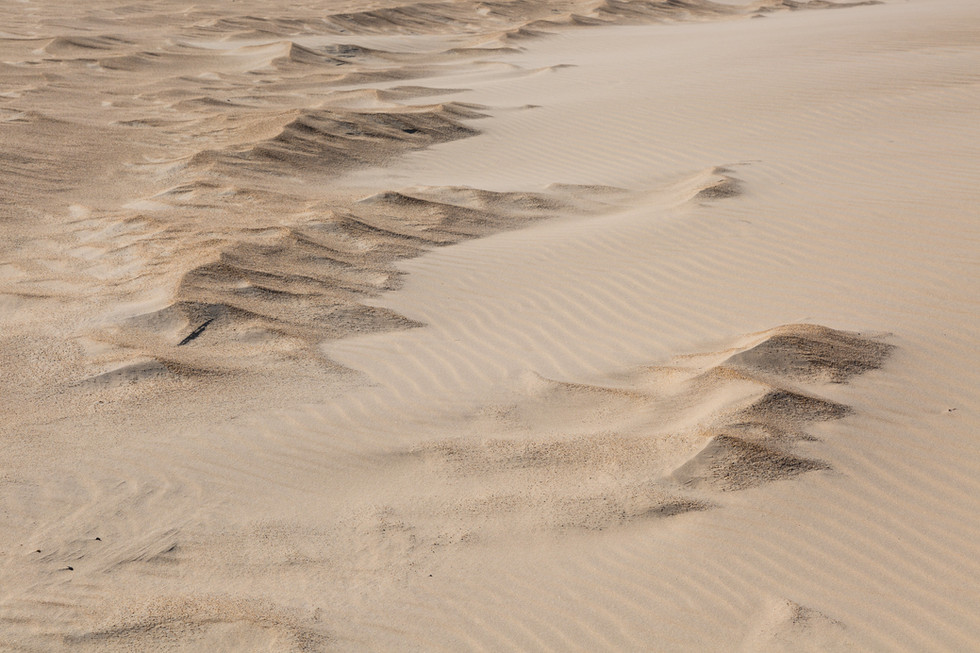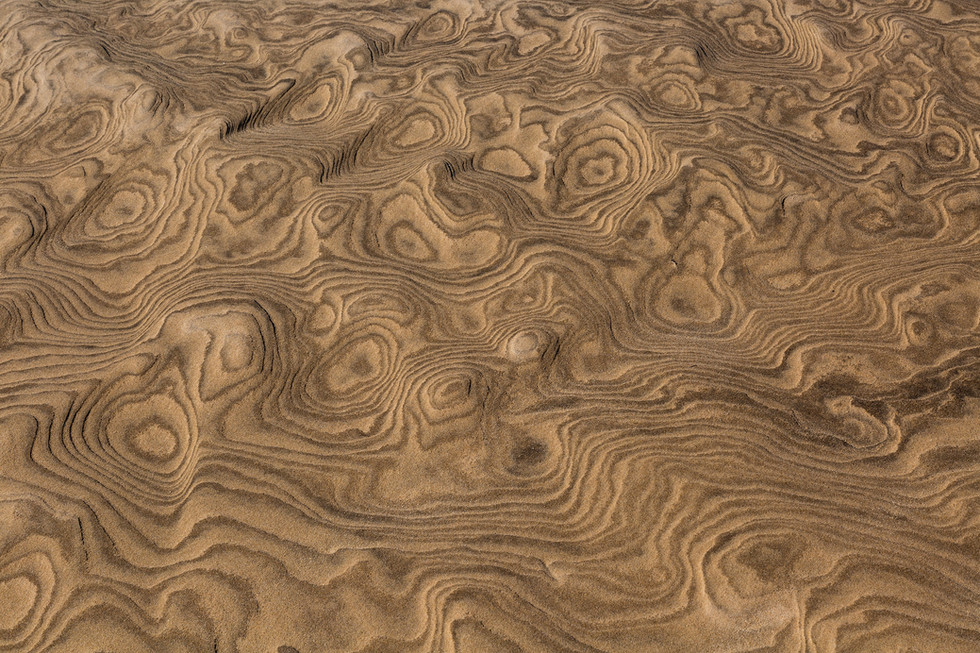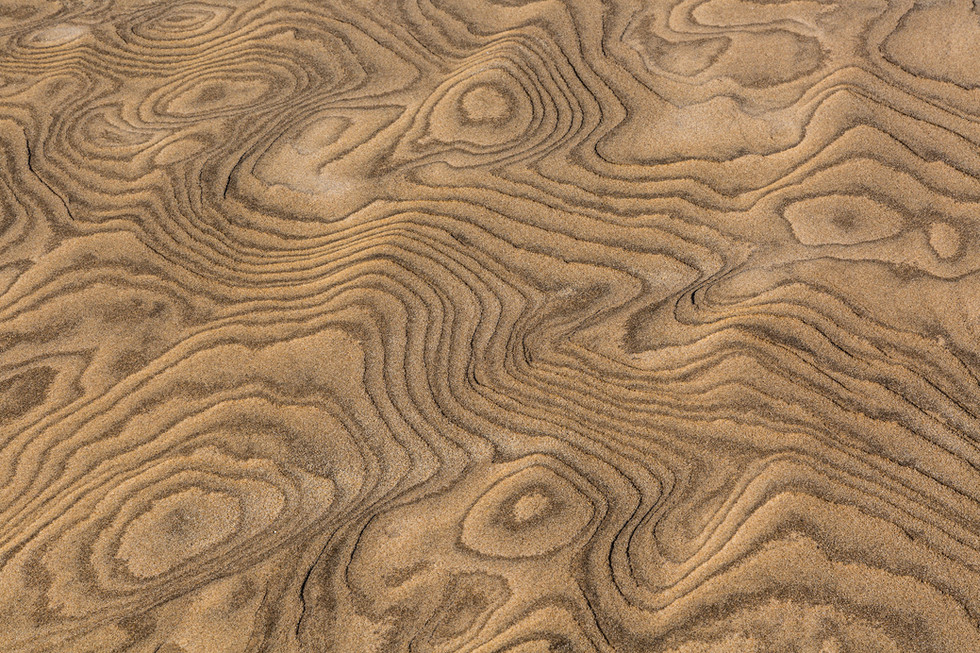Everywhere you look in the park, there are abstracts. The dunes are in a constant state of flux. As opposed to the formation of the abstracts on the beach, these are all a function of wind. The wind is constantly changing the shape and the location of the dunes. As this part of the country experiences some pretty violent storms off of the Atlantic, the changes can happen quickly and dramatically. I saw it for myself during the trip when the entire low area of the park was flooded with water. The dunes experience perpetual movement from the wind. The scenery is beautiful and the abstracts are amazing.
There are abstracts that exist on the surface of the dunes, and then there are abstracts that occur from beneath the surface. These are the tight designs that are found toward the bottom of this article. These are more like outcroppings from the sand that is more easily blown. They are areas where the sand has been more compacted. The designs are intricate and quite spectacular.
Before you spend time with the images, I wanted to take a moment to explain a break I am going to be taking from my blog postings. I may post periodically but it won't be with the same frequency as the past. I'm going to be working on a project that I initiated years ago.
Sanford J. Siegel
Anthropology & Photography

I created my website to promote the book I wrote about the patient experience with transverse myelitis. As an amateur photographer and a photography student, I also was interested in a public place to show my favorite images, and particularly for my family and friends. Starting the blog also provided me a chance to describe and explain some of my photography, as well as my travel photography adventures. As the world is a complicated place and I'm loaded to the gills with opinions about most of the things going on, my blogs have morphed into sharing my opinions.
My life experiences have been all over kingdom come. My website reflects some of those complicated intersections. Some of my blogs and my book reflect the decades of work I've been engaged in with The Transverse Myelitis Association, (now the Siegel Rare Neuroimmune Association). Pauline and I helped to establish the organization when she was diagnosed with TM in 1994. I have served as the president for a long time.
I began my formal education in photography about ten years ago at Columbus State Community College. I still consider myself a student and plan to return to the classroom soon. I took a break while I was completing my book. My hiatus from school was extended after Pauline died. And then covid happened, and school took a much longer break. I'm anxious to return to my photography classes.
My website is Sanford J. Siegel Anthropology and Photography. I am a cultural anthropologist. I did two years of fieldwork research between 1976 and 1978. I lived and worked on the Fort Belknap Reservation. I lived in a community of about 600 people who were primarily the A’aniiih (the White Clay People) and the Metis. The third group on the reservation are the Assiniboine. At the time of my work, the A’aniiih were called the Gros Ventre. This is the formal name used by the federal government in treaties and other legal references. This is not the name the tribe uses for itself. The Metis are the descendants of French trappers and traders who married Chippewa and Cree women.
I received my doctorate in anthropology in 1983. My life took a complicated turn in those years, and I never held a full time teaching position. I was an adjunct instructor in the 1980s and 1990s at a small liberal arts college in Columbus, Capital University. I was awarded Faculty of the Year in 1996. I considered that a great honor, particularly as I was only a part-time faculty member. That's all neither here nor there. I loved to teach, but it just wasn't in the cards for me.
The two years I spent on the reservation totally changed my life. First, as an anthropologist, my education and training have influenced my values and has shaped the way I see the world. In the job I held for more than 30 years, and that had nothing to do with academia, I feel as though I used anthropology in all facets of my work. Regarding the reservation, I made lifelong friendships and have remained attached to the land and to these people.
My time on the reservation was so incredibly complicated. I had this experience while I was in my mid-twenties. These two years changed me in such profound ways. When my father was in his early twenties, he entered the Army Air Corp during World War II and was stationed in Italy as a cryptographer. The service, the war and my father's experiences abroad totally changed him. It became a significant part of his personality, his values and his character. While I was on the reservation, I used to think about him a lot and how there were similarities in our ages and our experiences. The quality of our experiences were on opposite ends of the spectrum, but the influences on our lives were not. This was always driven home for me on the reservation by my relationship with a man and his family who took us in during that time. They treated us like we were members of their family. He was about my father's age and he had similar experiences during the war. He became 'my father' on the reservation and his family became our family. They still are like family. My strongest relationships on the reservation remain with his children and his nieces and nephews.
I came home from this experience with about 3,500 slides. The images are almost 50 years old. It took me years to digitize the images and it has taken me additional years to clean up about 50 years of dust and scratches. My next major project is going to be to repair as many of these photographs as I possibly can. For all of these years, I have thought about what I should do with these photographs. They represent a significant piece of history in this community and for these people.
When I created this website, I thought that this would be the place for me to post these images and to use my blog as a way to share some of the stories from that remarkable time in my life. Thus, the reference to the site being anthropology and photography. I also created the logo for this site to reflect the intersection of my photography with my love for the indigenous peoples and cultures; the camera and the dream catcher. It is believed that the Ojibwa, also referred to as the Chippewa, were the original creators of the dream catcher, but as with so many of the elements of Native American culture, the dream catcher and the folklore surrounding it spread throughout many of the tribes.
I returned home with so many stories. I have no motivation or interest in writing in an academic way about this experience. Over the years, the academic part of this has evaporated and my experiences became very personal. I'm more interested in sharing about my memories in a personal way. My hope is to share my love for this community along with the images from those years on Fort Belknap.
I will continue to post current images along the way, but I would like to devote as much of my time and energy as is possible to getting this project completed. At the time we lived on the reservation, it was primarily a home for the elderly and for the very young. I'll explain that demographic at some point in my storytelling. So many of our friends were seniors. As such, over the years, we have experienced so many losses. On my visits back to the reservation, I have gone to the cemeteries to pay my respects and to say Kaddish for these people who I loved and lost. I would love to get this project completed for their children and their grandchildren.
And, now, for the amazing abstracts in the sand ....













































I, too, find dunes to be so intriguing. Their changing shapes influenced by the wind completely reinforce the beauty of Nature. You capture them so well.📷